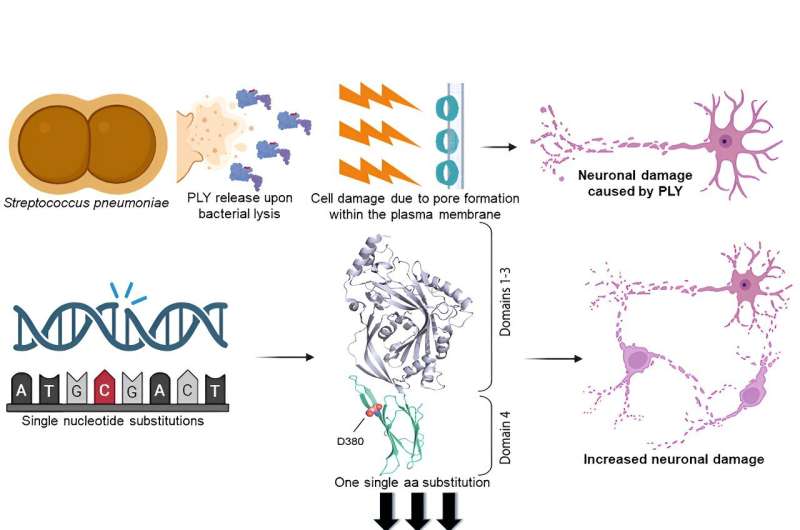This article has been reviewed according to Science X's editorial process and policies. Editors have highlighted the following attributes while ensuring the content's credibility:
fact-checked
peer-reviewed publication
trusted source
proofread
New insights into the mechanisms of bacterial brain invasion during meningitis

Bacterial meningitis is a devastating infectious disease because, even when cured, most survivors live with permanent neurological disabilities such as motor impairment, cognitive delay, hearing and vision loss, seizures, and psychiatric disorders, due to neuronal damage caused by the infection. Researchers at Karolinska Institutet have now revealed new insights into the mechanisms of bacterial brain invasion and neuronal damage during bacterial meningitis.
The bacterium Streptococcus pneumoniae (the pneumococcus) is the primary cause of meningitis globally. The pneumococcus produces and releases pneumolysin (PLY), which is one of the major weapons used by the bacteria to damage cells.
One single amino acid substitution in pneumolysin
"We discovered that Streptococcus pneumoniae, isolated from meningitis patients, release a variant of PLY which differs from only one single amino acid compared to the NCBI PLY-reference Streptococcus pneumoniae laboratory strain D39. This single amino acid substitution significantly enhances the capability of PLY to damage neurons," says Simona Serra, Ph.D. student in Federico Iovino's research group at the Department of Neuroscience and first author of the study.
"We shed light into how one single amino acid substitution can dramatically affect the toxic power of PLY," says Federico Iovino, Associate Professor and research group leader at the Department of Neuroscience.
This study was published in iScience.
The brain invasion pattern of Streptococcus pneumoniae
In a separate study, the researchers performed 3D whole-brain imaging to determine the pattern of brain invasion by blood-borne Streptococcus pneumoniae.
"We have observed that all regions of the brain are equally affected by pneumococcal infection in experimental meningitis in vivo model and, furthermore, that neurogenesis is severely affected during meningitis pathogenesis," says Kristine Farmen, a Ph.D. student in Iovino's research group at the Department of Neuroscience and first author of this second study.
This study was performed in collaboration with Dr. Katrin Wellfelt and Prof. Lars Olson, both at the same department. The article was published in Neurobiology of Disease.
"The findings support the real scenario of meningitis in society; in fact, the different brain regions, equally affected by bacterial invasion, control different body functions, and this corresponds to the incredible variety of neurological sequelae experienced by meningitis survivors," says Iovino, last author and principal investigator of the study.
Each year, there are approximately 2,5 million cases of bacterial meningitis globally, and most of them are caused by Streptococcus pneumoniae. It is, therefore, plausible to hypothesize that new variants of PLY with different cytotoxic capabilities toward neurons are still out there to be discovered.
The finding that Streptococcus pneumoniae can invade all brain regions is a fundamental piece of knowledge that highlights the need to find new therapeutic approaches to protect neurons in all brain regions from bacterial interaction and from PLY exposure.
"PLY, with its incredible capabilities to injure neurons and disrupt neuronal activity, has a major role in the onset of neurological disabilities experienced by up to 70 percent of meningitis survivors. Our goal is to understand bacterial interactions with brain cells to develop new approaches to block such interactions and protect the brain from bacterial infections," says Iovino.
More information: Simona Serra et al, The single D380 amino acid substitution increases pneumolysin cytotoxicity toward neuronal cells, iScience (2024). DOI: 10.1016/j.isci.2024.109583
Kristine Farmen et al, Spatio-temporal brain invasion pattern of Streptococcus pneumoniae and dynamic changes in the cellular environment in bacteremia-derived meningitis, Neurobiology of Disease (2024). DOI: 10.1016/j.nbd.2024.106484




















